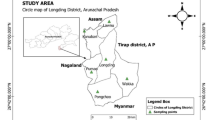Abstract
The proximate composition of three varieties ofPiper guineense (Odusa — Ibibio/Efik) viz. ‘Uyat Odusa’ (cultivated and peppery), ‘Eting-keni Ikot’ (wild forest variety) and ‘Eting-keni mben inyang’ (wild, riverine variety), were determined using available standard methods. Also determined were mineral, antinutrient and ascorbate levels. The cultivated pepperic variety had the highest content of crude protein and moisture (18.9% and 97% respectively) while the wild, riverine variety had the highest content of ether extract, carbohydrate and calories (7.79%, 63.38% and 398 cals respectively). The cultivated variety had appreciable amounts of phosphorus (1.12 mg/100 g), potassium (1.2 mg/100 g), sodium (0.24 mg/100 g), zinc (0.18 mg/100 g), and copper (0.18 mg/100 g) while the forest variety contained more of calcium (12.38 mg/100 g), magnesium (1.21 mg/100 g) and iron (0.85 mg/100 g). The wild riverine variety appeared to have the least mineral content but had the highest ascorbate level of 173.4 mg/100 g. Of four antinutrients assayed, the cultivated pepperic one had the least quantities while the forest variety was highest in hydrocyanic acid (85.8 mg/100 g) and glucosinolates (0.20 mg/100 g). The wild riverine variety had the highest level of total oxalate (165.0 mg/100 g). These quantities are however far below documented toxic levels.
Similar content being viewed by others
References
AOAC (1975) Official Methods of Analaysis. 12th ed. Washington, DC: Association of Official Analytical Chemists.
Dye WB (1956) Studies onHalogeton glomeratus. Weed 4: 55–58.
Oke OL (1965) Chemical studies on some Nigerian foodstuffs. W African Pharm 8: 92–95.
Burns RF (1971) Methods of estimation of tannin in the grain sorghum. Agron J 63: 511–515.
Croft AC (1979) The determination of total glucosinolates in rapeseed meal by titration of enzyme liberated acid: The identification of individual glucosinolates. J Sci Food Agric 30: 417–423.
Ifon ET (1977) Nutrient composition of some Nigerian leafy green vegetables and the physiological availability of their iron contents. Ph.D. Thesis. Biochemistry Department, University of Ibadan, Nigeria. pp. 20–120.
Leakey CL, Wills JB (1977) Food crops of the lowland tropics, 13th ed. Oxford University Press, pp. 101–123.
Eyo EJ, Mohme E, Abel HO (1983) Chemical composition and amino-acid contents ofGnetum africanum, Heinsia crinita, andPiper guineense. Nig J Nutri Sci 4(1): 57–62.
Oke OL (1969) Role of hydrocyanic-acid in nutrition. World Rev Nutri Dietet 11: 170–174.
Dietz HM (1989) Composition of foods: Glucosinolates in oil-seeds and vegetables: Their significance and methods of analysis. Food Lab News 16:31–35.
Munro A, Bassir O (1969) Oxalate in Nigerian vegetables. W African J Biol Appld Chem 12: 14–17.
Author information
Authors and Affiliations
Rights and permissions
About this article
Cite this article
Isong, E.U., Essien, I.B. Nutrient and antinutrient composition of three varieties ofPiper species. Plant Food Hum Nutr 49, 133–137 (1996). https://doi.org/10.1007/BF01091970
Received:
Accepted:
Issue Date:
DOI: https://doi.org/10.1007/BF01091970




